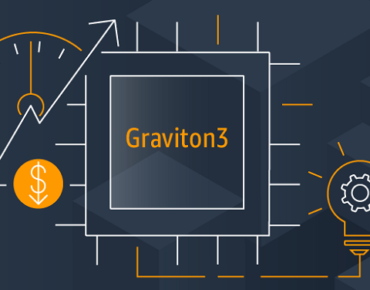AWS Boosting Performance with New Graviton3-Based Instances Now Available in Preview

Three years after unveiling the first generation of its AWS Graviton chip-powered instances in 2018, Amazon Web Services just announced that the third generation of the processors – the AWS Graviton3 – will power all-new Amazon Elastic Compute 2 (EC2) C7g instances that are now available in preview.
Debuting at the AWS re:Invent 2021 conference in Las Vegas, the new Graviton3-powered instances will deliver up to 25 percent faster compute performance and up to 2x higher floating-point performance compared to the current generation of AWS EC2 C6g Graviton2-powered instances, according to AWS. The new Graviton3 instances are also up to 2x faster when running cryptographic workloads compared to AWS Graviton2 instances, the company said.
For machine learning workloads, the new Graviton3-powered instances are expected to deliver up to 3x better performance compared to Graviton2-powered instances, including support for bfloat16, said AWS.
 The AWS Graviton chips are Arm-based 7nm processors designed by AWS and custom-built for cloud workloads by Israeli-based engineering firm Annapurna Labs, which AWS acquired about six years ago. All Graviton processors include dedicated cores and caches for each vCPU. AWS customers today have a choice of about 12 different Graviton2-powered instances. The AWS Graviton2 processors debuted in late 2019, a year after the initial Graviton chips were unveiled.
The AWS Graviton chips are Arm-based 7nm processors designed by AWS and custom-built for cloud workloads by Israeli-based engineering firm Annapurna Labs, which AWS acquired about six years ago. All Graviton processors include dedicated cores and caches for each vCPU. AWS customers today have a choice of about 12 different Graviton2-powered instances. The AWS Graviton2 processors debuted in late 2019, a year after the initial Graviton chips were unveiled.
The announcement of the latest Graviton3-powered EC2 C7g instances accompanied the debut of several other new EC2 instances from AWS, including EC2 Trn1 instances powered by AWS Trainium chips and Amazon EC2 Im4gn/Is4gen/I4i instances featuring new AWS Nitro SSDs for improved storage performance for I/O-intensive workloads, according to the company. All three new instances are aimed at helping AWS customers improve the performance, cost and energy efficiency of their workloads running on Amazon EC2.
The new EC2 Trn1 and Im4gn/Is4gen/I4i instances add additional options for AWS customers, who have been using other EC2 instances such as Inf1 in the past, Adam Selipsky, AWS’ CEO, said during his Nov. 30 keynote at the event. The Inf1 instances run on AWS Inferentia chips and provide machine learning inferencing. The Inf1 instances debuted in 2019. The AWS Trainium chips, which arrived in 2020, are used for training deep learning models in the Trn1 instances.
“With our investments in AWS-designed chips, customers have realized huge price performance benefits for some of today’s most business-critical workloads,” David Brown, vice president of Amazon EC2, said in a statement. “These customers have asked us to continue pushing the envelope with each new EC2 instance generation.”
One existing AWS customer that is interested in using the new Graviton3 instances is social media network, Twitter, Nick Tornow, the head of platform for the company, said in a statement.
“Twitter is working on a multi-year project to leverage the AWS Graviton-based EC2 instances to deliver Twitter timelines,” said Tornow. The company evaluated the new Graviton3-based C7g instances and found they delivered 20 percent to 80 percent higher performance compared to the current Graviton2-based C6g instances, while also reducing tail latencies by as much as 35 percent, he said. “We are excited to utilize Graviton3-based instances in the future to realize significant price performance benefits.”
Maribel Lopez, principal analyst with Lopez Research, told EnterpriseAI that the new EC2 instances are possible because AWS saw a need for these services in the marketplace and then figured out how to fill those needs for customers.
“Chips are the gateway to innovation and differentiation,” said Lopez. “Look at any major tech launch and someone will be talking about how a chip is creating a new experience or a cheaper experience. With AWS's tech prowess, it is no wonder that they decided to develop a custom product for both cost and performance. Intel is the top dog, but increasingly companies are looking outside of Intel so they can differentiate.”
For AWS to make it all happen, though, they needed the help of chip-IP vendor Arm Ltd., which was able to take AWS’ designs and turn them into real-world silicon, said Lopez. “Arm has done a great job of getting itself embedded in companies that want to do their own processors, such as AWS and Apple,” she said.
Jack E. Gold, the president and principal analyst of J. Gold Associates, said that most cloud customers that use Graviton instances do so because the instances are less expensive to run compared to instances using Intel Xeon chips, due to lower costs for power consumption and for the chips themselves.
“But while Graviton works well for many workloads that are not compute intensive, the majority of high performance workloads still work on the higher power Intel or AMD chips,” said Gold. “Indeed, AWS also builds custom silicon – Trainium – for optimized AI training, even as they offer more compute intensive Nvidia/Intel AI chip instances. So, Graviton enables AWS to offer a more economical cloud instance and as a result, expands their market to more applications, such as web serving, streaming, data collection, office apps and more.”
Gold said this is important for AWS and other cloud providers that are creating and using their own custom chips so they can create broader offerings as the cloud expands to encompass more use cases and continues to be a replacement for on-premises compute workloads.
“I expect to see AWS and others continue to develop their own optimized chips built on Arm IP, but I do not see AWS moving away from more traditional Intel/AMD/Nvidia chips for customers who need the power these chips provide,” he said.
According to AWS, the new Graviton3-powered instances are up to 60 percent more energy efficient than the previous Graviton2-powered EC2 instances. The C7g instances use the latest DDR5 memory, which provides 50 percent higher memory bandwidth compared to AWS Graviton2-based instances, which improves the performance of memory-intensive applications like scientific computing. The C7g instances also deliver 20 percent higher networking bandwidth capabilities compared to AWS Graviton2-based instances and support Elastic Fabric Adapter (EFA), which allows applications to communicate directly with network interface cards, enhancing the performance of HPC and other applications.
In a Nov. 30 blog post announcing the new Graviton3 instances, Jeff Barr, the chief evangelist for AWS, wrote that that the new offerings will better serve customers who need to run compute-intensive workloads including HPC, batch processing, electronic design automation (EDA), media encoding, scientific modeling, ad serving, distributed analytics, and CPU-based machine learning inferencing.
“While we are still optimizing these instances, it is clear that the Graviton3 is going to deliver amazing performance,” wrote Barr.
Users can sign up for the preview of the C7g instances immediately and give them a test drive, he wrote. C7g instances will be available in multiple sizes, including bare metal.














